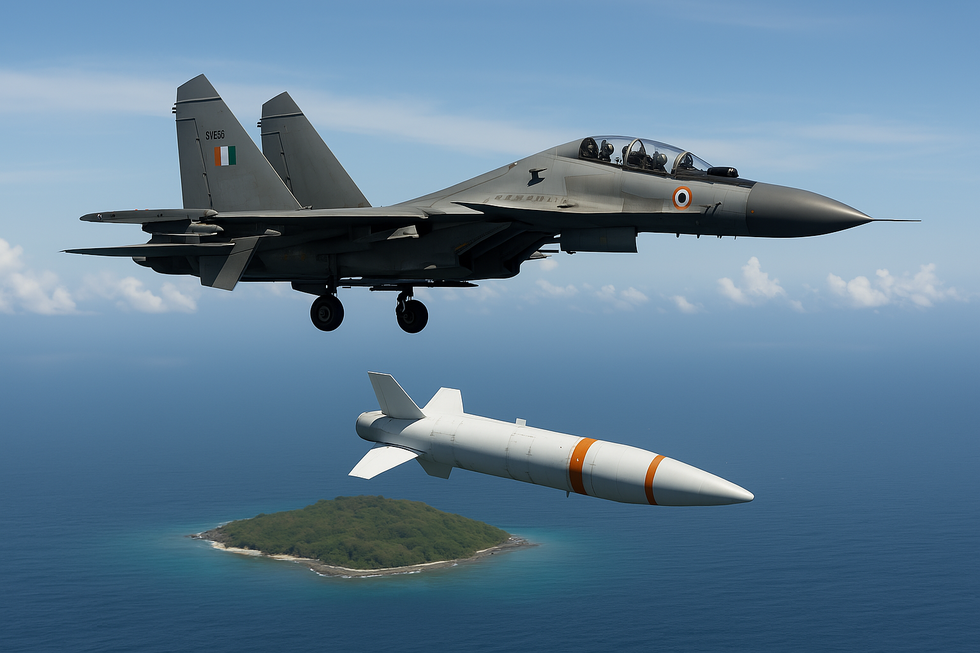Description

Source: ET
Disclaimer: Copyright infringement not intended.
Context:
- India has successfully test-fired its first indigenous anti-radiation missile, the Rudram-1, developed by the Defence Research and Development Organisation (DRDO) for the Indian Air Force (IAF).
- This significant achievement underscores India's progress in developing advanced defense technologies crucial for modern warfare.
About Rudram-1:
Rudram-1 is India’s first indigenous anti-radiation missile developed by the Defence Research and Development Organisation (DRDO). The missile is designed to suppress enemy air defenses by targeting and destroying radar installations, communication sites, and other radio frequency emitting sources.
Key Features of Rudram-1
- The Rudram-1 missile is integrated with the IAF’s Sukhoi-30MKI fighter jets, serving as a potent platform for its deployment.
- Equipped with INS-GPS navigation and a Passive Homing Head, the missile ensures precise targeting of radiation-emitting sources.
- This capability is pivotal for the Suppression of Enemy Air Defence (SEAD) missions, enabling the IAF to neutralize enemy radars and communication systems from extended ranges.
Technical Specifications
- Type: Air-to-surface missile
- Range: Approximately 250 km
- Speed: Supersonic Guidance
- System: Passive homing head for targeting radiation emissions
- Launch Platform: Capable of being launched from Sukhoi Su-30MKI fighters
Comparative Analysis with Global Counterparts
United States: AGM-88 HARM
- The United States’ AGM-88 High-speed Anti-Radiation Missile (HARM) has been in service for over three decades.
- It is designed to detect, attack, and destroy radar antennas or transmitters with minimal aircrew input.
- The AGM-88 HARM claims a sophisticated seeker head and is used extensively by the S. Air Force and Navy for SEAD missions.
Russia: Kh-58
- Russia’s Kh-58 anti-radiation missile, with a range of 120 kilometers, is known for its versatility. It can be fitted with various seeker heads targeting specific air defense radars.
- The Kh-58 has been a key component of the Russian SEAD arsenal, providing flexibility and effectiveness in neutralizing enemy radar systems.
United Kingdom: ALARM
- The British Royal Air Force uses the Air-Launched Anti-Radiation Missile (ALARM) to destroy enemy radars.
- Designed for SEAD missions, ALARM can loiter above the battlefield, waiting for enemy radars to activate before attacking. This capability allows for sustained suppression of enemy air defenses.
China: FT-2000
- China’s FT-2000 system, based on the HQ-9 (which itself is derived from the Russian S-300PMU), targets Airborne Early Warning (AEW) and Airborne Warning and Control System (AWACS) aircraft.
- This system exemplifies China’s approach to developing anti-radiation missiles tailored to counter high-value, radar-emitting targets.
Iran: Hormoz-2
- The Iranian Hormoz-2 anti-radiation missile is a ballistic missile capable of striking targets at sea with a range of approximately 300 kilometers.
- It highlights Iran’s focus on extending its anti-radiation capabilities to maritime environments, providing strategic flexibility.
Brazil: MAR-1
- Brazil’s MAR-1 missile, developed by Mectron, has been exported to countries like Pakistan.
- It demonstrates Brazil’s capability to produce competitive anti-radiation missiles for the global market.
- The MAR-1 is designed to effectively suppress enemy air defenses by targeting radar systems.

Strategic Implications for India
- The successful test of Rudram-1 marks a significant advancement in India’s defense capabilities.
- With China and Pakistan posing ongoing security challenges, India’s development of indigenous anti-radiation missiles enhances its strategic deterrence.
- The missile’s integration with Su-30MKIs allows the IAF to conduct SEAD operations deep within enemy territory, neutralizing critical air defense installations.
Technological Edge and Operational Flexibility
- Rudram-1’s INS-GPS navigation and Passive Homing Head provide a technological edge, enabling accurate targeting over a wide range of frequencies.
- The missile can be launched from varying altitudes, ranging from 500 meters to 15 kilometers, and has a range of up to 250 kilometers depending on the launch conditions.
- This flexibility allows the IAF to adapt to different operational scenarios, enhancing its combat effectiveness.
Source:
https://www.financialexpress.com/business/defence-india-successfully-test-fires-new-generation-anti-radiation-missile-rudram-1-3541569/
|
PRACTICE QUESTION
With reference to the Rudram-1 missile, consider the following statements:
- Rudram-1 is designed to be launched from the Sukhoi Su-30MKI fighter jet.
- It is developed by the Defence Research and Development Organisation (DRDO).
- Rudram-1 can target enemy bunkers and underground storage facilities.
Which of the above statements is/are correct?
(a) 1 and 2 only
(b) 2 and 3 only
(c) 1 and 3 only
(d) 1, 2, and 3
Correct Answer: (a) 1 and 2 only.
|
















